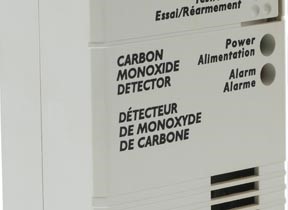Carbon monoxide poisoning causes an estimated 15,200 people to visit an emergency room or miss at least one day of work per year. But because carbon monoxide exposure creates nonspecific effects that are easily misdiagnosed, the actual toll of carbon monoxide poisoning is probably much higher.
Carbon monoxide (CO) is a colorless, odorless, toxic gas that results from the incomplete combustion of fossil fuels such as natural or liquefied petroleum gas, oil, wood, and coal. It is one of the oldest documented poisons.
When breathed, carbon monoxide displaces oxygen in the blood and deprives the heart, brain, and other vital organs of oxygen. Large amounts of CO can overcome you in minutes without warning—causing you to lose consciousness and suffocate.
The symptoms and effects of CO exposure vary greatly from person to person depending on age, overall health and the concentration and length of exposure. For lower-level exposures (below 100 ppm), symptoms may include headache, dizziness, and nausea. People with heart problems may experience chest pain. Higher levels of exposure (above 150-200 ppm) may result in disorientation, unconsciousness, and death. In addition, a growing body of evidence has associated chronic low-level exposure to ambient air CO to higher incidence of cardiovascular disease, stroke and adverse birth outcomes.
The non-specific nature of the symptoms makes it easy to attribute CO poisoning symptoms to other causes, such as the flu. And because it is impossible to see, taste or smell the toxic fumes, CO can kill you before you are aware of it.
Potential sources of CO exposure exist in most workplaces in the U.S., including furnaces, motor vehicles, generators, gas heaters and other small-engine powered appliances. As the weather gets cooler and people move indoors and increase the use of heaters, the risk of CO exposure increases.
To Prevent CO Poisoning:
Install an effective ventilation system.
Maintain equipment and appliances (e.g., water heaters, space heaters, cooking ranges) that can produce CO in good working order to promote their safe operation and to reduce CO formation.
Consider switching from gasoline-powered equipment to equipment powered by electricity, batteries, or compressed air if it can be used safely.
Prohibit the use of gasoline-powered engines or tools in poorly ventilated areas.
Provide personal CO monitors with audible alarms if potential exposure to CO exists.
Test air regularly in areas where CO may be present, including confined spaces.
Install CO monitors with audible alarms.
Use a full-facepiece pressure-demand self-contained breathing apparatus (SCBA) certified by the National Institute for Occupational Safety and Health (NIOSH), or a combination full-facepiece pressure demand supplied-air respirator with auxiliary self-contained air supply in areas with high CO concentrations, i.e., those immediately dangerous to life and health atmospheres.
Use respirators with appropriate canisters for short periods when CO levels are not exceedingly high.
Educate workers about the sources and conditions that may result in CO poisoning as well as the symptoms and control of CO exposure.
Ensure that workers test for oxygen sufficiency before entering confined spaces where the presence of CO is suspected.
When you suspect CO poisoning, promptly taking the following actions can save lives:
- Call 911 or another local emergency number for medical attention or assistance.
- Administer 100-percent oxygen using a tight-fitting mask if the victim is breathing.
- Administer cardiopulmonary resuscitation if the victim has stopped breathing.
- Employers should make sure that rescuers are not exposed to dangerous CO levels when performing rescue operations. Rescuers should be skilled at performing recovery operations and using recovery equipment.
CO Alarms Can Save Lives
Carbon monoxide alarms are designed to alarm before potentially life-threatening levels of CO are reached. CO alarms may be installed into a plug-in receptacle or high on the wall. Hard wired or plug-in CO alarms should have battery backup. Avoid locations that are near heating vents or that can be covered by furniture or draperies. The Consumer Products Safety Commission does not recommend installing CO alarms in kitchens or above fuel-burning appliances.
After installing a CO alarm, test it to make sure it functions properly, following the manufacturer’s instructions. And note the alarm’s replacement in a tickler file—alarms have a recommended replacement age, which can be obtained from the product literature or from the manufacturer.
Currently marketed CO alarms are not as susceptible to nuisance alarms as earlier models. If a CO alarm sounds, do not ignore it!
Move everyone in the area outside, to fresh air.
Call your emergency services, fire department, or 911.
After calling 911, do a head count to check that all persons are accounted for. DO NOT reenter the premises until the emergency services responders have given you permission.
If malfunctioning equipment has created the CO, DO NOT operate that equipment until it has been properly serviced by trained personnel.
For more information on reducing the risks of CO poisoning and other indoor air hazards, please contact us.



